Unit4 Exploring planets Warming up and Reading课件(33张PPT)
文档属性
| 名称 | Unit4 Exploring planets Warming up and Reading课件(33张PPT) | 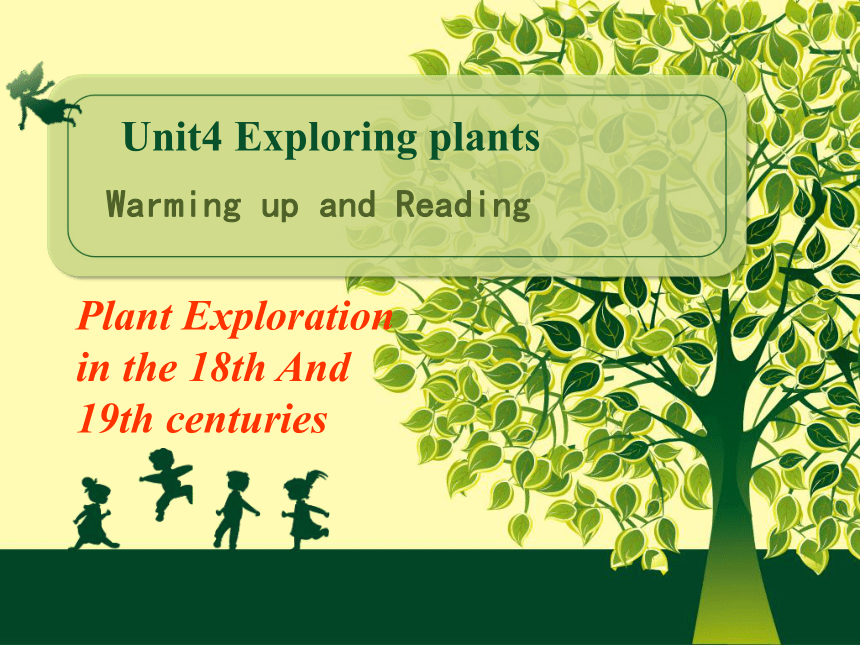 | |
| 格式 | zip | ||
| 文件大小 | 7.2MB | ||
| 资源类型 | 教案 | ||
| 版本资源 | 人教版(新课程标准) | ||
| 科目 | 英语 | ||
| 更新时间 | 2019-10-26 20:25:49 | ||
图片预览



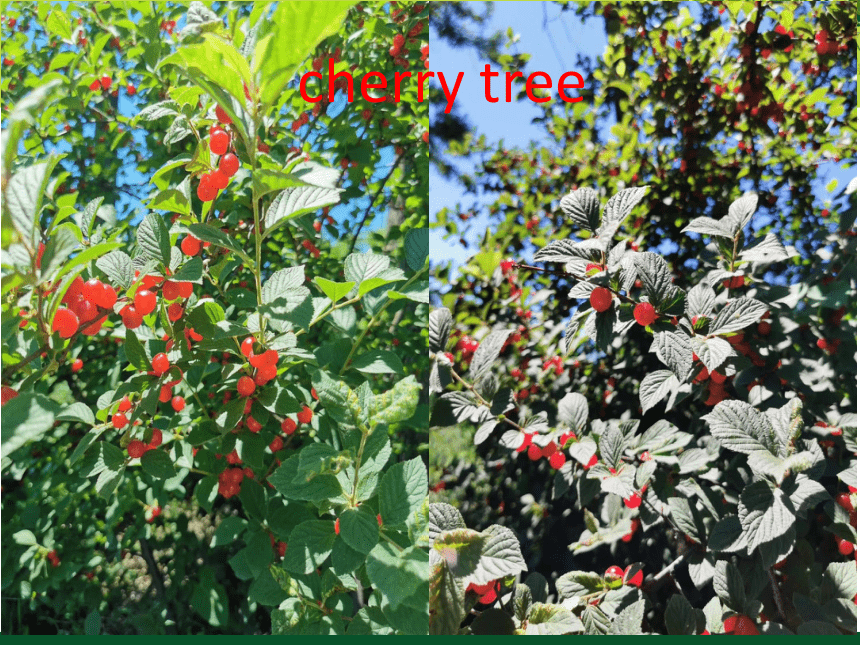

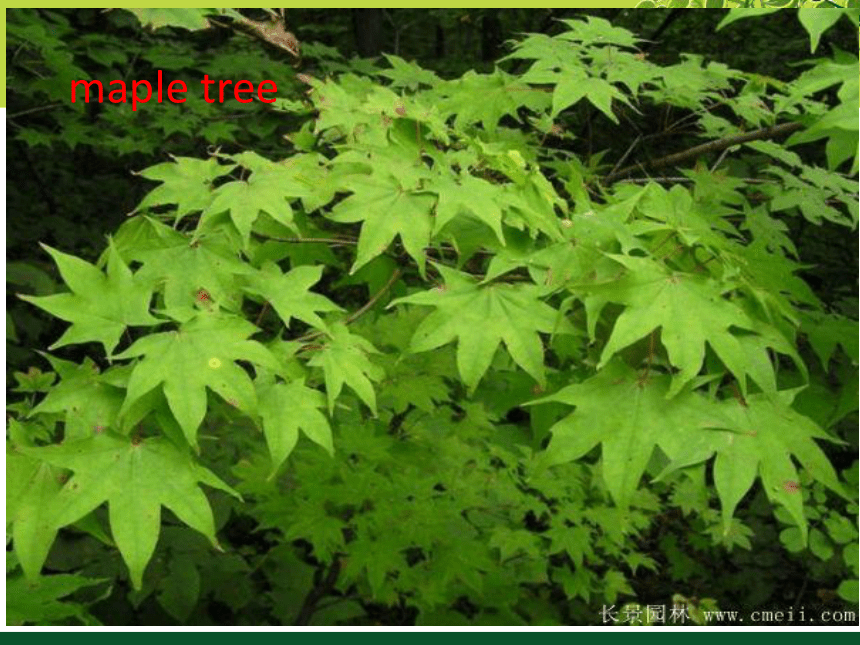
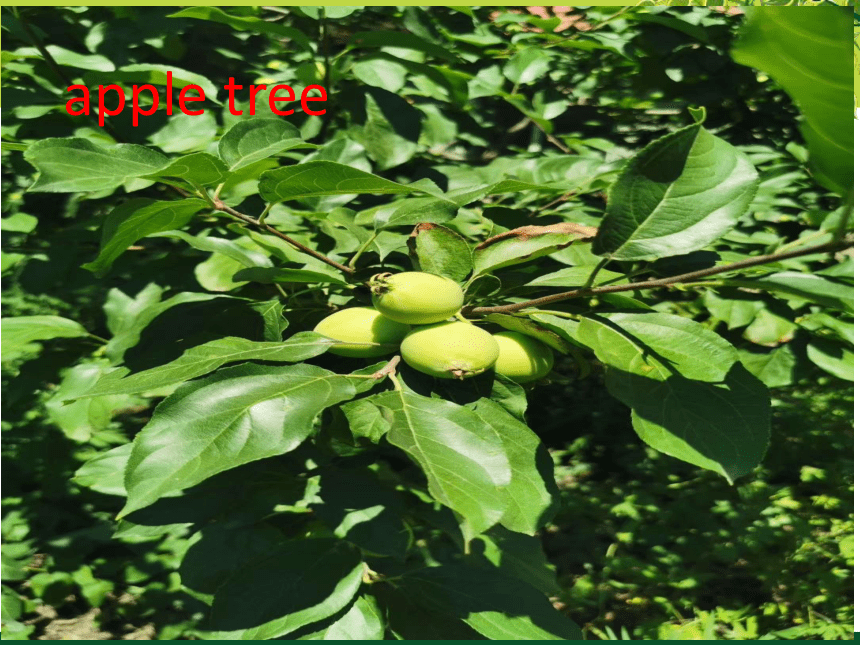
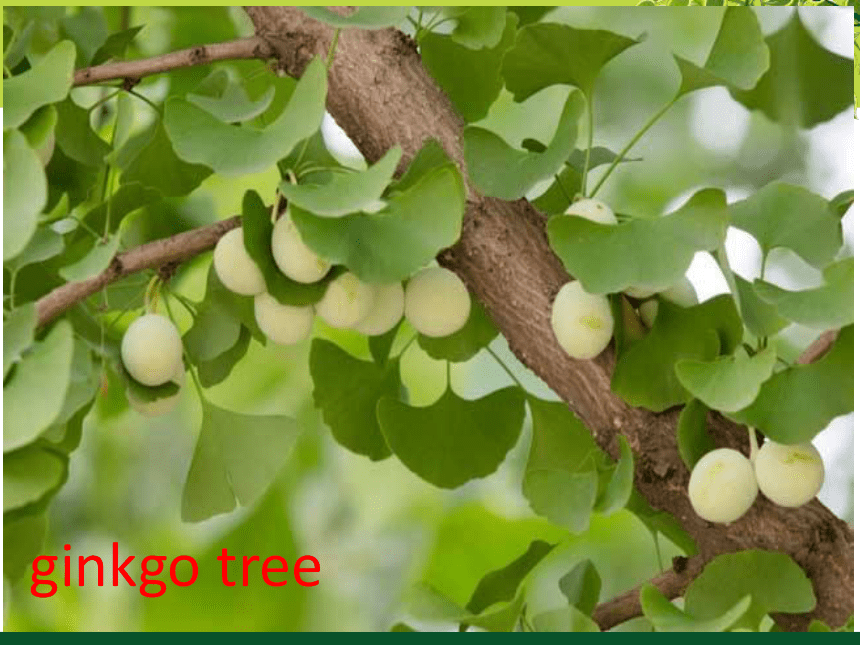
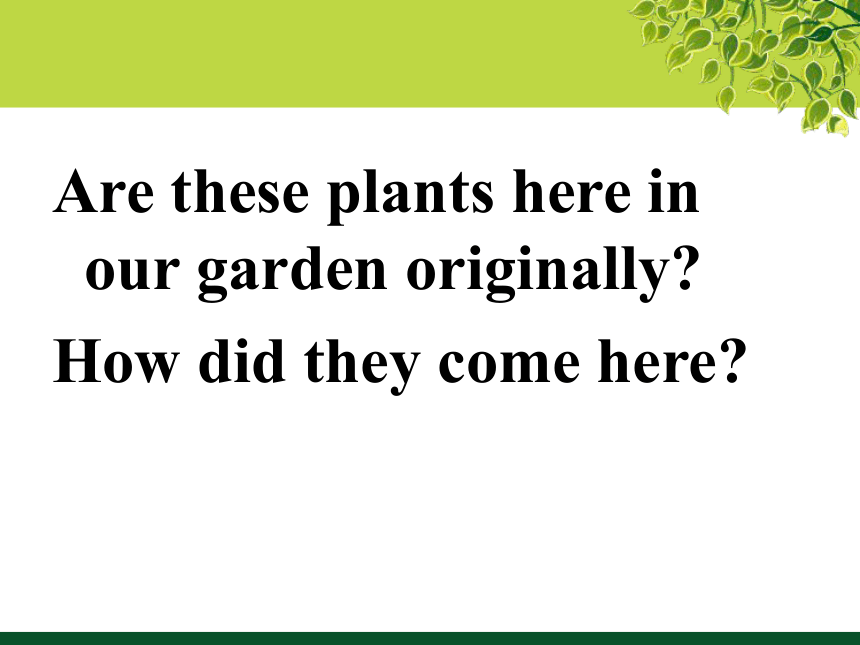

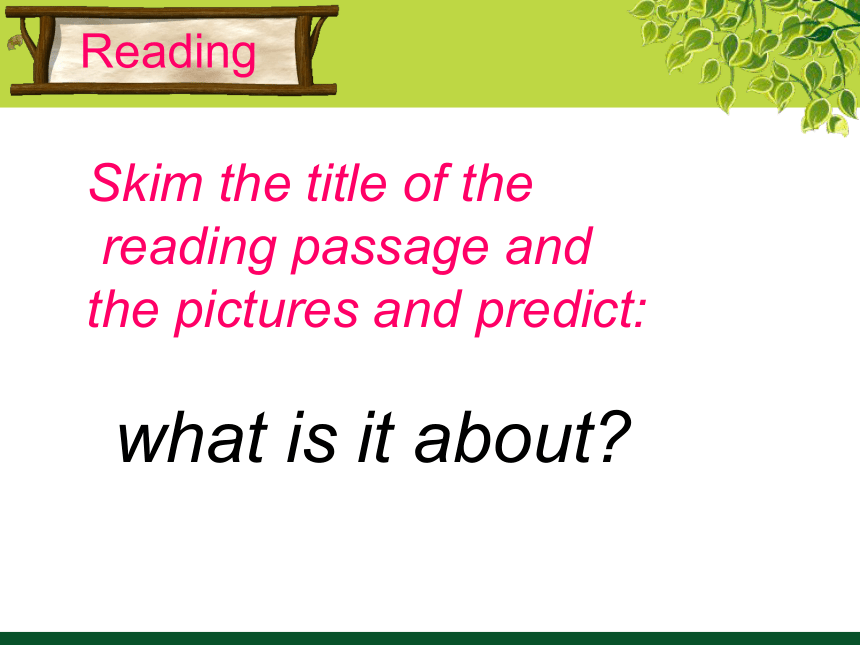
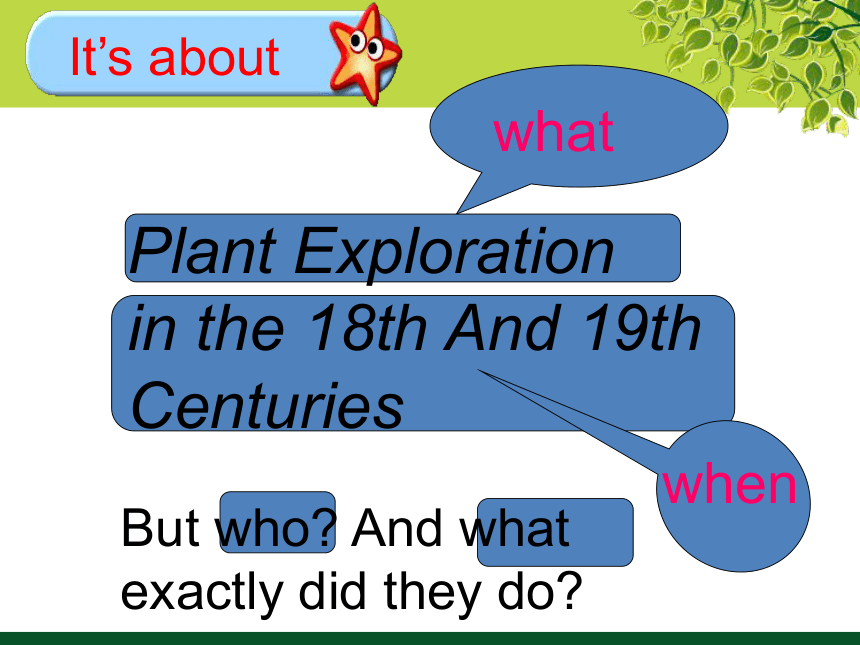
文档简介
(共33张PPT)
Warming up and Reading
Unit4 Exploring plants
Plant Exploration in the 18th And 19th centuries
How much do you know about plants?
Warming up
Let’s enjoy some pictures of plants in our school
Are you familiar with the following trees?
cherry tree
pine tree
maple tree
apple tree
ginkgo tree
Are these plants here in our garden originally?
How did they come here?
Skim the title of the
reading passage and
the pictures and predict:
Reading
what is it about?
Plant Exploration
in the 18th And 19th Centuries
It’s about
what
But who? And what exactly did they do?
when
Try to get the main idea of each paragraph:
Para 1:
explains when plant collecting began.
Para 2:
describes when and where plant collecting began on a large scale by Europeans.
Para 3:
talks about French Catholic missionaries who collected plants in China in the 18th century.
Scanning
Para 4:
is about the famous British plant collector, Sir Joseph Banks, who collected many new plants in Australia.
Para 5:
explains the problems of keeping plants alive on long trips.
Para 6:
describes an experiment carried out by Dr Nathaniel Ward who invented a glass case in which to transport plants on long journeys.
Para 8:
is about Father Farges, a French Catholic missionary who collected plants in China in the 19th century.
Para 7:
is about Robert Fortune, a British plant collector who made several trips to China in the 19th century.
Para 9:
Describes how many European plant collectors, such as E H Wilson, went to China so that new plants could be introduced to gardens in the West.
Structure:
Part I:
Para1-2 the beginning of
plant collecting
Part II:
Para3-4 the exploration
of plants in the 18th century
Part III:
Para 5-7 the invention and
use of Wardian case
Part IV:
Para 8-9 the exploration
of plants in the 19th centry
T or F
1. The plants in our garden grew in China originally.
F
2. The American Middle Classes took great interest in collecting new plants during the 18th and 19th centuries.
F
para1
para2
Many of them come from countries far away.
The European middle class
Detailed reading:
3. French Catholic missionaries were beginning to set themselves up in China by the middle of the 18th century.
4. After Father d’ Incarville died, some Tree of Heaven seeds were sent to England.
F
T
para3
para3
Before
5. Banks, together with James Cook, collected many examples of plants in Australia.
6. Keeping plants alive during long land or sea voyage was very
difficult, which caused the Wardian Case to be invented.
T
T
para4
para5
7. Robert Fortune introduced over 120 species of plants to Western Gardens, because he could easily travel everywhere in China.
8. During the second half of the 19th century, many Catholic missionaries were sent to China, and they collected many seeds of plants, which were sent back to France.
F
T
para7
para8
He learned to speak Chinese fluently so he could easily travel everywhere in China.
1.Brave young men took the opportunity of going on botanical expeditions, often facing many dangers including disease, near-starvation, severe environments and conflicts with the local people.(Para. 2)
勇敢的年轻人借机进行植物探索活动, 他们常常面临许多危险, 如疾病、饥饿、严酷的环境以及同当地居民的冲突。
结构分析:动词-ing短语often facing...people作谓语took the opportunity的伴随状语; including disease... people作名词dangers的后置定语。
2. Not only did Fortune introduce over l20 species of plants to Western gardens but he also shipped 20, 000 tea plants from Shanghai to India, where a successful tea industry was established. (Para 7 )
福琼不仅把120余种植物引进入西方的园林, 而且
还用船将两万株茶树从上海运到印度, 印度的制茶
工业就成功地发展起来了。
3.At that time, there were restrictions on the movement of Europeans and so, in order to travel unnoticed, he developed his fluency in Chinese and dressed as a Chinese man, even shaving his head in the Chinese style. (para 7)
那时候,欧洲人在中国的活动受到种种限制,因此,
为了在旅行中不引起别人的注意,他努力使自己的
汉语讲得很流利,并且穿着中国人的服装,甚至像
中国人一样削发(留辫)。
Discussion
If you are a botanist from Britain and you are asked by the King to collect seeds of trees from China ,What will you prepare? why?
Do you think plant exploration is meaningful ? why?
Summary
Read the passage again and write down the summary in about 30 words
The plant exploration began on a large scale between the eighteenth and nineteenth centuries. Some missionaries and plant collectors introduced many exotic plants into different countries with the help of the Wardian case.
1.The plants in our gardens look so_______
____________________________________
我们花园里的植物看起来很熟悉,我们没有意识到
很多植物来自于很远的国家。
Consolidation
familiar that often we do not realize that many of them actually come from countries far away.
2._________ “exotic”plants, as they are called, ______________________________
收集所谓的“异国”植物的行为要追溯到很久以前。
Collecting
dates back to the earliest times.
3. However, ______________ the eighteenth and nineteenth centuries_______________ ____________________________________
然而, 直到18和19世纪人们对植物世界大规模的探索才
开始。
句型: It is/was not until ...that... 直到……才……
(强调句型)
that the exploration
of the botanical world began on a large scale
it was not until
4.Sir Joseph Banks was a very famous British plant collector, ____________ James Cook_________________________ __________.
约瑟夫·班克斯爵士是一位著名的植物收集家,他曾经
陪同詹姆斯·库克进行了从英国到大洋洲的首次航行.
who accompanied
on his first voyage from England
to Oceania
5.This invention, ______________________,
allowed plants _______________________
______.
这项发明被称为沃德箱,它可以用来进行远距离的
植物运输。
called the Wardian case
to be transported on long
journey.
Homework
1. Finish off the exercises in the workbook.
2. Learn the text by heart.
Warming up and Reading
Unit4 Exploring plants
Plant Exploration in the 18th And 19th centuries
How much do you know about plants?
Warming up
Let’s enjoy some pictures of plants in our school
Are you familiar with the following trees?
cherry tree
pine tree
maple tree
apple tree
ginkgo tree
Are these plants here in our garden originally?
How did they come here?
Skim the title of the
reading passage and
the pictures and predict:
Reading
what is it about?
Plant Exploration
in the 18th And 19th Centuries
It’s about
what
But who? And what exactly did they do?
when
Try to get the main idea of each paragraph:
Para 1:
explains when plant collecting began.
Para 2:
describes when and where plant collecting began on a large scale by Europeans.
Para 3:
talks about French Catholic missionaries who collected plants in China in the 18th century.
Scanning
Para 4:
is about the famous British plant collector, Sir Joseph Banks, who collected many new plants in Australia.
Para 5:
explains the problems of keeping plants alive on long trips.
Para 6:
describes an experiment carried out by Dr Nathaniel Ward who invented a glass case in which to transport plants on long journeys.
Para 8:
is about Father Farges, a French Catholic missionary who collected plants in China in the 19th century.
Para 7:
is about Robert Fortune, a British plant collector who made several trips to China in the 19th century.
Para 9:
Describes how many European plant collectors, such as E H Wilson, went to China so that new plants could be introduced to gardens in the West.
Structure:
Part I:
Para1-2 the beginning of
plant collecting
Part II:
Para3-4 the exploration
of plants in the 18th century
Part III:
Para 5-7 the invention and
use of Wardian case
Part IV:
Para 8-9 the exploration
of plants in the 19th centry
T or F
1. The plants in our garden grew in China originally.
F
2. The American Middle Classes took great interest in collecting new plants during the 18th and 19th centuries.
F
para1
para2
Many of them come from countries far away.
The European middle class
Detailed reading:
3. French Catholic missionaries were beginning to set themselves up in China by the middle of the 18th century.
4. After Father d’ Incarville died, some Tree of Heaven seeds were sent to England.
F
T
para3
para3
Before
5. Banks, together with James Cook, collected many examples of plants in Australia.
6. Keeping plants alive during long land or sea voyage was very
difficult, which caused the Wardian Case to be invented.
T
T
para4
para5
7. Robert Fortune introduced over 120 species of plants to Western Gardens, because he could easily travel everywhere in China.
8. During the second half of the 19th century, many Catholic missionaries were sent to China, and they collected many seeds of plants, which were sent back to France.
F
T
para7
para8
He learned to speak Chinese fluently so he could easily travel everywhere in China.
1.Brave young men took the opportunity of going on botanical expeditions, often facing many dangers including disease, near-starvation, severe environments and conflicts with the local people.(Para. 2)
勇敢的年轻人借机进行植物探索活动, 他们常常面临许多危险, 如疾病、饥饿、严酷的环境以及同当地居民的冲突。
结构分析:动词-ing短语often facing...people作谓语took the opportunity的伴随状语; including disease... people作名词dangers的后置定语。
2. Not only did Fortune introduce over l20 species of plants to Western gardens but he also shipped 20, 000 tea plants from Shanghai to India, where a successful tea industry was established. (Para 7 )
福琼不仅把120余种植物引进入西方的园林, 而且
还用船将两万株茶树从上海运到印度, 印度的制茶
工业就成功地发展起来了。
3.At that time, there were restrictions on the movement of Europeans and so, in order to travel unnoticed, he developed his fluency in Chinese and dressed as a Chinese man, even shaving his head in the Chinese style. (para 7)
那时候,欧洲人在中国的活动受到种种限制,因此,
为了在旅行中不引起别人的注意,他努力使自己的
汉语讲得很流利,并且穿着中国人的服装,甚至像
中国人一样削发(留辫)。
Discussion
If you are a botanist from Britain and you are asked by the King to collect seeds of trees from China ,What will you prepare? why?
Do you think plant exploration is meaningful ? why?
Summary
Read the passage again and write down the summary in about 30 words
The plant exploration began on a large scale between the eighteenth and nineteenth centuries. Some missionaries and plant collectors introduced many exotic plants into different countries with the help of the Wardian case.
1.The plants in our gardens look so_______
____________________________________
我们花园里的植物看起来很熟悉,我们没有意识到
很多植物来自于很远的国家。
Consolidation
familiar that often we do not realize that many of them actually come from countries far away.
2._________ “exotic”plants, as they are called, ______________________________
收集所谓的“异国”植物的行为要追溯到很久以前。
Collecting
dates back to the earliest times.
3. However, ______________ the eighteenth and nineteenth centuries_______________ ____________________________________
然而, 直到18和19世纪人们对植物世界大规模的探索才
开始。
句型: It is/was not until ...that... 直到……才……
(强调句型)
that the exploration
of the botanical world began on a large scale
it was not until
4.Sir Joseph Banks was a very famous British plant collector, ____________ James Cook_________________________ __________.
约瑟夫·班克斯爵士是一位著名的植物收集家,他曾经
陪同詹姆斯·库克进行了从英国到大洋洲的首次航行.
who accompanied
on his first voyage from England
to Oceania
5.This invention, ______________________,
allowed plants _______________________
______.
这项发明被称为沃德箱,它可以用来进行远距离的
植物运输。
called the Wardian case
to be transported on long
journey.
Homework
1. Finish off the exercises in the workbook.
2. Learn the text by heart.
